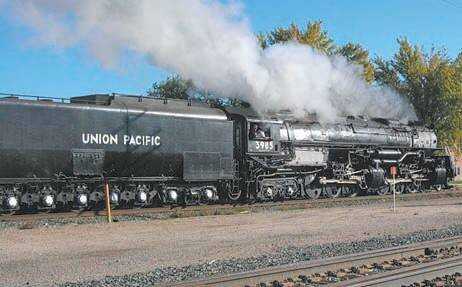Steam locomotive makes historic pass through town

Mountain Home and Glenns Ferry residents got a brief and rare glimpse of the past Monday morning when Union Pacific Challenger No. 3985, an articulated steam locomotive, passed through the communities on its way to Shoshone.
The mammoth engine is on a six-state, 2,800-mile tour from Cheyenne, Wyo. to Portland, Ore., making stops in Ogden, Utah, Portola and Roseville, Calif., Eugene and Portland, Ore., before heading to Pocatello via Boise.
The train was scheduled to leave Nampa at about 9 a.m. Monday morning, traveling at an average speed of 70 m.p.h. But the train left from its overnight stop early, traveling through Glenns Ferry at about 9:38 a.m.
In Glenns Ferry at least a dozen railroad enthusiasts lined the tracks along Commercial Avenue to watch the engine roll by. The train slowed down to negotiate the curve at the east end of town before picking up steam and continuing its journey towards Shoshone.
Scores of other spectators parked along the side of the road between Glenns Ferry and King Hill to watch the train roll by.
The giant locomotive, weighing more than 1 million pounds, was built in 1943 by the American Locomotive Company, and was in regular service until 1957. It is the only operating engine of its class in the world today, and is the largest and most powerful operating steam engine.
The engine was retired in 1962 and stored in the roundhouse in Cheyenne until 1975 when it was placed on display near the Cheyenne depot. A group of Union Pacific employees volunteered their services to restore the locomotive to running condition in 1981.
Challenger No. 3985 has a "hinged" frame, allowing it to negotiate curves. It is 122 feet long with six-foot diameter drive wheels and can reach a top speed of 70 miles per hour. Originally built for fast freight service it was officially retired in 1959.
The name Challenger was given to steam locomotives with a 4-6-6-4 wheel arrangement. This means that they have four wheels in the leading "pilot" truck, which helps guide the locomotive into curves; two sets of six "driving" wheels, and finally, four "trailing" wheels, which support the rear of the engine and its massive firebox.
Each set of driving wheels has its own steam cylinder. The result, in essence, is two engines under one boiler.
When watching the approaching locomotive navigate a curve, one can see the boiler swing out left or right independently of the lower half of the engine, as the rear half of the locomotive remains in a straight direction until its wheels and frame are halfway through the curve. That is because of the locomotive's hinged design.
Although Challengers were originally designed for fast freight service, they occasionally pulled passenger trains. No. 3985 originally burned coal and pulled a tender with a 32-ton capacity.
It also carried 25,000 gallons of water. In 1990, it was converted to use No. 5 oil.
Additional information on the Challengers and other steam locomotives can be found on the Union Pacific website at www.up.com.
